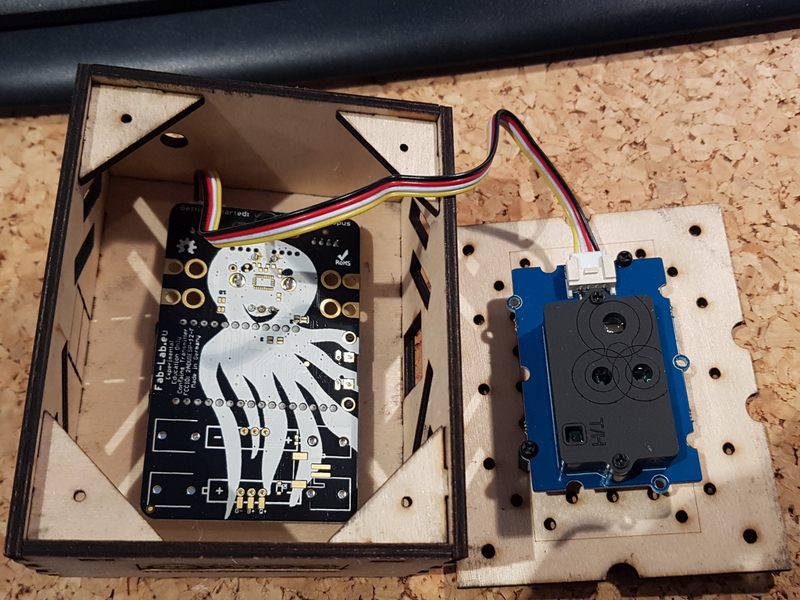5
Helga Schwab
Wie jedes Jahr traf sich die Familie (vier Erwachsene und ein Kind) am Weihnachtsabend 2020 zum Festschmaus, anschließender Bescherung und zum traditionellen Spieleabend mit Cluedo. Und das zu einer Zeit, in der es wegen Corona gewisse Einschränkungen gab – jedoch noch keine Schnelltests, geschweige gegen das Virus geimpfte Personen.
Was lag näher, als dass ich mein selbst programmiertes Octopus-Gerät zum Einsatz brachte. Mit Netzanschluss an das Stromnetz angeschlossen – und schon funktionierte es: Es zeigte die CO2 Messwerte an; waren sie zu hoch, musste gelüftet werden, sank der Wert, wurde das Fenster wieder geschlossen. Und das musste in einem kurzen Zeitraum erfolgen: Fenster öffnen, Fenster schließen …

Erste Schritte beim Programmieren
Gebastelt hatte ich diese CO2-Ampel während eines virtuellen Workshops von SLO im August/September desselben Jahres. Leider besaß ich anfangs noch kein Gerät (Lieferschwierigkeiten wegen Ferienzeit), so dass ich anfangs dem Workshop nur bedingt folgen konnte. Endlich war es soweit. Doch was sollte ich tun als unerfahrene Programmiererin?
Auf Anraten von Horst beschäftigte ich mich zunächst mit der Seite
https://www.umwelt-campus.de/iot-werkstatt/tutorials – Schritte 1-3
Nach dem Herunterladen des Programms, Installieren des USB-Treibers und Anschließen des Octopus-Geräts an meinen PC versuchte ich mich mit der ersten Übung. Natürlich war dies für mich sehr anstrengend, da ich die vielen technischen Begriffe oft nicht verstand und diese mir erst nach und nach (in meinem Alter!) einprägen konnte. Doch welche Freude, als mein Octopus blinkte: rot, rot, grün, rot, rot, grün …
Nach einigen weiteren Versuchen gelang es schließlich, mein Gerät weiter zu programmieren, ihm Befehle einzugeben, deren Reihenfolge mir jedoch etwas unklar war. Umso mehr freute es mich, dass es zumindest an Heilig Abend funktionierte und meine Angehörigen zum Staunen brachte.
Fazit
Mein Fazit nach diesem ersten Workshop lautet: Nicht aufgeben, nie den Mut verlieren, auch in meinem Alter! Jetzt versuche ich ein Gerät zu programmieren, das nicht nur CO2-Werte misst und anzeigt, sondern auch Temperatur und Luftfeuchtigkeit.
As every year, the family (four adults and one child) met on Christmas Eve 2020 to celebrate, the subsequent exchange of presents and the traditional game evening with Cluedo. At a time there were certain restrictions due to Corona – but yet no rapid tests, let alone vaccination against the virus. What could be more natural than to use my self-programmed Octopus device. Pluged in with low current power supply – and it worked: It showed the CO2 readings; if they were too high, we had to open the window; when the value fell, it could be closed again. And that had to be done within a short period of time: open window, close window …

First steps in programming
I had tinkered with this CO2 traffic light during a virtual workshop by SLO in August / September of the same year. Unfortunately, at the beginning I did not have a device (delivery problems due to vacation time), so that at first I was only able to follow the workshop to a limited extent. At last the device arrived. But I had no idea what to do with it, as I was inexperienced in programming.
On the advice of Horst, I first looked at the site https://www.umwelt-campus.de/iot-werkstatt/tutorials – steps 1-3
After downloading the program, installing the USB driver and connecting the Octopus device to my PC, I tried the first exercise. Of course, this was very strenuous for me, as I often did not understand the many technical terms and could only memorize them gradually (at my age!). But what a joy when my octopus blinked: red, red, green, red, red, green …
After a few more attempts, I finally succeeded in further programming my device, giving it commands, the order of which, however, was somewhat unclear to me. So I was all the more pleased that it worked at least on Christmas Eve and amazed my relatives.
Conclusion
My conclusion after this first workshop is: Don’t give up, don´t lose your patience, even in old age! Now I’m trying to program a device that not only measures and displays CO2 values, but also temperature and humidity.
